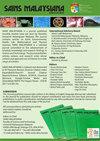一种新的南极细菌,环状细菌sp.SO2的基因组分析为其生产抗菌化合物的基因组潜力提供了见解
IF 0.7
4区 综合性期刊
Q3 MULTIDISCIPLINARY SCIENCES
引用次数: 0
摘要
从南极分离出一种名为SO2的低温细菌新菌株。因此,本研究旨在进一步了解Cryobacterium sp. SO2产生的抗菌化合物和次生代谢物。结果表明,菌株SO2为革兰氏阳性,呈不规则棒状,在半固体培养基上形成黄色至橙色的色素菌落。菌株SO2在4到25℃的温度范围内生长。完整基因组大小为4.097 Mb, SO2的DNA G+C含量为68.43%,基因组注释显示该基因组包含3862个CDS、10个rRNA、55个tRNA和1个tm-RNA。系统发育和正位分析表明,其最近的系统发育邻居是Cryobacterium sp.菌株SO1、N22、TMB1-8、LW097、TMN39-1、C. zongtaiiTMN-42、C. arcticumPAMC27867和C. soli GCJ02。基因组注释显示,菌株SO2具有β-内酰胺酶A类、头孢菌素- c去乙酰化酶和27个耐药编码基因,对头孢他啶具有耐药性。功能注释发现28.74%的预测基因功能未知。基因组挖掘表明,菌株SO2可能存在6个次生代谢物基因簇。它们由含rre、萜烯、-内酯、T3PKS、NAPAA和2do组成。这一发现表明菌株SO2含有可能参与产生具有抗菌和抗氧化活性的化合物的基因。本文章由计算机程序翻译,如有差异,请以英文原文为准。
Genomic Analysis of a Novel Antarctic Bacterium, Cyrobacterium sp.SO2 Provides Insights into its Genomic Potential for Production of Antimicrobial Compounds
A novel strain of Cryobacterium designated as SO2, was isolated from the Antarctic. Hence, this study was undertaken to gain further insight into the antimicrobial compounds and secondary metabolites produced by Cryobacterium sp. SO2. It was found that strain SO2 is a Gram-positive that exhibits an irregular rod shape, which formed yellow to orange pigmented colonies on semi-solid media. Strain SO2 grows at temperatures ranging from 4 to 25 ºC. It has a complete genomic size of 4.097 Mb. SO2 has a DNA G+C content of 68.43%, and genomic annotation showed that the genome contained 3,862 CDS, 10 rRNA, 55 tRNA and 1 tm-RNA. Phylogenetic and OrthoANI analysis suggested Cryobacterium sp. strains SO1, N22, TMB1-8, LW097, TMN39-1, C. zongtaiiTMN-42, C. arcticumPAMC27867 and C. soli GCJ02 as its closest phylogenetic neighbour. Genome annotation shows that strain SO2 confers β-lactamase class A, cephalosporin-C deacetylases, and 27 drug-resistance encoding genes, and allows resistance to ceftazidime. Functional annotation identifies 28.74% of predicted genes are of unknown functions. Genome mining indicates that there are six putative secondary metabolite gene clusters in strain SO2. They are made up of RRE-containing, terpene, beta-lactone, T3PKS, NAPAA, and 2dos. This finding shows strain SO2 harbours genes that may be involved in the production of compounds with antibacterial and antioxidant activities.
求助全文
通过发布文献求助,成功后即可免费获取论文全文。
去求助
来源期刊

Sains Malaysiana
MULTIDISCIPLINARY SCIENCES-
CiteScore
1.60
自引率
12.50%
发文量
196
审稿时长
3-6 weeks
期刊介绍:
Sains Malaysiana is a refereed journal committed to the advancement of scholarly knowledge and research findings of the several branches of science and technology. It contains articles on Earth Sciences, Health Sciences, Life Sciences, Mathematical Sciences and Physical Sciences. The journal publishes articles, reviews, and research notes whose content and approach are of interest to a wide range of scholars. Sains Malaysiana is published by the UKM Press an its autonomous Editorial Board are drawn from the Faculty of Science and Technology, Universiti Kebangsaan Malaysia. In addition, distinguished scholars from local and foreign universities are appointed to serve as advisory board members and referees.
 求助内容:
求助内容: 应助结果提醒方式:
应助结果提醒方式:


